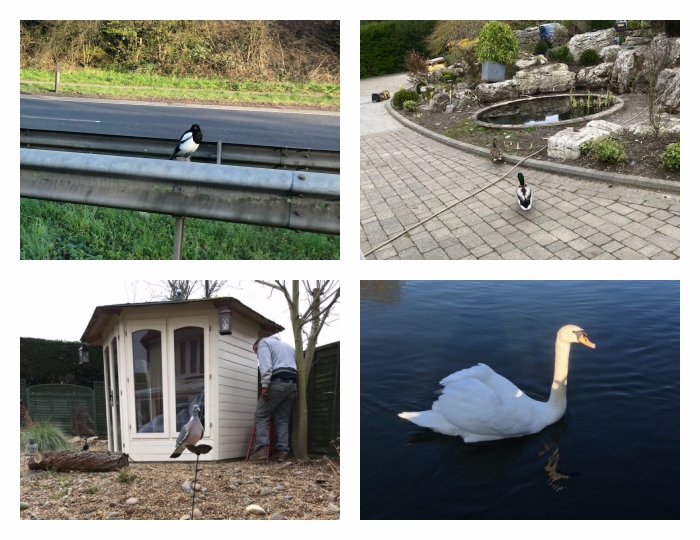
05 Apr UK Birds Love Helping Rosewood!
Rosewood Bird Helpers
UK birds love helping Rosewood! We work in so many wonderful gardens, large and small, but we notice one thing wherever we go. There are bird helpers (and other wildlife) attending every job.
Today we’re sharing four pictures taken recently. A magpie came to eye us up while the van was stopped at the roadside. The ducks decided that the tiny pond in the bed we were irrigating looked extremely inviting. The swan came to look at us working, and the woodpigeon… well, if you look closely, you’ll see why we’re ignoring that one.
A few fun facts about the birds
Magpies
Magpies are instantly recognisable, with their beautiful black-and-white plumage. Like other corvids (members of the crow family), they are not only among the most intelligent of all birds, but the most intelligent of all species full stop. Magpie brain to body mass ratio equals that of great apes (chimpanzees, gorillas and orang utans) and cetaceans (whales and dolphins). The magpie is the only bird species to have passed the mirror test (measuring visual self-awareness), something that few other species of any kind have done. Perhaps this intelligence makes humans mistrust them. We certainly have lots of superstitions surrounding them, including the well known rhyme that begins ‘One for sorrow’.
Mallards
The mallard is our most common duck species. The male is unmistakable, with a glossy bottle-green head and a white collar separating the head from the body. The female has a speckled brown colouration similar to several other duck species. Ducklings are yellow for the first few weeks, before they grow into juvenile versions of adult plumage. The mallard was the first species in which the predator-avoidance technique of sleeping with one eye open was observed. It’s not just the eye that’s open, either: one hemisphere of the bird’s brain is fully alert while the other half sleeps!!
Mute Swans
Mute swans are another easily recognisable bird, having pure white plumage all over and an orange bill surrounded by black. They have a large native range, and go back a long way. Fossil remains have been found in East Anglia dating back more than 6000 years!! These early mute swans differed from the living birds only in size. Swans are territorial, and are keen to defend their partners and cygnets. The old story of a swan’s wings being strong enough to break an adult man’s leg isn’t true, but they will certainly attack a person or animal they perceive as a threat.
Our bird helpers
These photos were all taken in the last couple of weeks, but over the course of the year, we see countless other species, including robins, blackbirds and many others. It’s one of the reasons we love working outside in gardens. We enjoy their presence, and like knowing what they are. If you see a bird you don’t recognise in your garden, you can head to the RSPB website to identify a bird.
Alternatively, if what you need is irrigation help, call Rosewood, on 01727 811448! We’re waiting to take your call.

